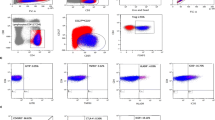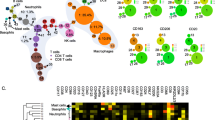Abstract
Objective
To identify and characterize endometriosis-associated immune cell infiltrates (EMaICI). Furthermore, to define occurrence and size of EMaICI in various types of endometriosis.
Methods
Immune cells were characterized in samples of 60 premenopausal women with histological proven endometriosis. Therefore, immunohistochemical staining with monoclonal antibodies for CD3, CD4, CD8, CD45RO, CD25, CD56, CD68, and CD20 on sections of paraffin-embedded endometriotic tissue was performed.
Results
EMaICI were observed in all the types of endometriosis, and characterized as T lymphocytes (CD3+), helper T lymphocytes (CD4+), cytotoxic T lymphocytes (CD8+), antigen-experienced T lymphocytes”memory cells” (CD45RO+), macrophages (CD68+), and B lymphocytes (CD20+). The maximum frequency of EMaICI and their distribution per endometriotic lesion (EML) was observed in peritoneal endometriosis (pEM) and in ovarian endometriosis (Ov. EM). In myometrium from adenomyosis (M/AM), EMaICI occurrence was lower and smaller in size in comparison with EMaICI seen in other forms of endometriosis. EMaICI were negative for regulatory T cells (CD25+ high, FoxP3+) and natural killer cells (NK cells, CD56+).
Conclusion
Numerous and brisk EMaICI comprising several types of immune cells in all endometriosis forms suggest acute immunological reactions within the microenvironment of endometriosis lesions.


Similar content being viewed by others
Abbreviations
- AM:
-
Adenomyosis
- CD:
-
Cluster of differentiation
- DIE:
-
Deep infiltrating rectovaginal endometriosis
- EDT:
-
Endometriosis disease theory
- EM:
-
Endometriosis
- EMaICI:
-
Endometriosis-associated immune cell infiltrates
- EML:
-
Endometriotic lesions
- EN1/pEM:
-
Endometrium from patients with peritoneal EM
- EN2/AM:
-
Endometrium from adenomyosis
- EN3k/UM:
-
Endometrium from uterus myomatosus, used as control
- ICI:
-
Immune cell infiltrates
- IHC:
-
Immunohistochemistry
- M/AM:
-
Myometrium from adenomyosis
- M/UM:
-
Myometrium from myomatosus uterus, used as control
- NK:
-
Natural killer cells
- NLP:
-
Non-lesional peritoneum, used as control
- NLO:
-
Non-lesional ovarium, used as control
- Ov. EM:
-
Ovarian endometriosis
- p EM:
-
Peritoneal endometriosis
- p:
-
Proliferative phase
- s:
-
Secretory phase
References
Ebert A (2006) Endometriose. Walter de Gruyter, Berlin. In: Update 2006
Meyer R (1919) Uber den Stand der Frage der Adenomyositis und Adenomyome in allgemeinen und insbesondere über Adenomyositis serosoepithlialis und Adenomyometritis sarcomatosa. ZentralblGynäkol 43:745–750
Sampson JA (1927) Metastatic or embolic endometriosis, due to the menstrual dissemination of endometrial tissue into the venous circulation. Am J Pathol 3(2):93–110, 143
Leyendecker G, Kunz G, Noe M, Herbertz M, Mall G (1998) Endometriosis: a dysfunction and disease of the archimetra. Hum Reprod Update 4(5):752–762
Leyendecker G, Wildt L, Mall G (2009) The pathophysiology of endometriosis and adenomyosis: tissue injury and repair. Arch Gynecol Obstet 280(4):529–538
Dmowski WP, Steele RW, Baker GF (1981) Deficient cellular immunity in endometriosis. Am J Obstet Gynecol 141(4):377–383
Morris H, Edwards J, Tiltman A, Emms M (1985) Endometrial lymphoid tissue: an immunohistological study. J Clin Pathol 38(6):644–652
Kamat BR, Isaacson PG (1987) The immunocytochemical distribution of leukocytic subpopulations in human endometrium. Am J Pathol 127(1):66–73
Marshall RJ, Jones DB (1988) An immunohistochemical study of lymphoid tissue in human endometrium. Int J Gynecol Pathol 7(3):225–235
Witz CA, Montoya IA, Dey TD, Schenken RS (1994) Characterization of lymphocyte subpopulations and T cell activation in endometriosis. Am J Reprod Immunol 32(3):173–179
Oosterlynck DJ, Cornillie FJ, Waer M, Koninckx PR (1993) Immunohistochemical characterization of leucocyte subpopulations in endometriotic lesions. Arch Gynecol Obstet 253(4):197–206
Startseva NV (1980) Clinical immunological aspects of genital endometriosis. Akush Ginekol (Mosk) 3:23–26
Mettler L, Volkov NI, Kulakov VI et al (1996) Lymphocyte Subsets in the Endometrium of patients with Endometriosis throughout the Menstrual Cycle. Am J Reprod Immunol 36:342–348
Revised American Society for Reproductive Medicine classification of endometriosis: 1996. Fertil Steril 1997, 67(5):817–821
Wang Y, Zhang L, Wang X (2001) Study on the distribution of lymphocyte subsets in the eutopic and ectopic endometrium of women with endometriosis. Zhonghua fu chan ke za zhi 36(2):85–88
Bulun SE (2009) Endometriosis. N Engl J Med 360(3):268–279
Szyllo K, Tchorzewski H, Banasik M, Glowacka E, Lewkowicz P, Kamer-Bartosinska A (2003) The involvement of T lymphocytes in the pathogenesis of endometriotic tissues overgrowth in women with endometriosis. Mediators Inflamm 12(3):131–138
Agic A, Xu H, Finas D, Banz C, Diedrich K, Hornung D (2006) Is endometriosis associated with systemic subclinical inflammation? Gynecol Obstet Invest 62(3):139–147
Braun DP, Muriana A, Gebel H, Rotman C, Rana N, Dmowski WP (1994) Monocyte-mediated enhancement of endometrial cell proliferation in women with endometriosis. Fertil Steril 61(1):78–84
Berbic M, Hey-Cunningham AJ, Ng C, Tokushige N, Ganewatta S, Markham R, Russell P, Fraser IS. The role of Foxp3+ regulatory T-cells in endometriosis: a potential controlling mechanism for a complex, chronic immunological condition. Hum Reprod 25(4):900–907
Osuga Y, Koga K, Hirota Y, Hirata T, Yoshino O, Taketani Y. Lymphocytes in endometriosis. Am J Reprod Immunol
Oosterlynck DJ, Cornillie FJ, Waer M, Vandeputte M, Koninckx PR (1991) Women with endometriosis show a defect in natural killer activity resulting in a decreased cytotoxicity to autologous endometrium. Fertil Steril 56(1):45–51
Wilson TJ, Hertzog PJ, Angus D, Munnery L, Wood EC, Kola I (1994) Decreased natural killer cell activity in endometriosis patients: relationship to disease pathogenesis. Fertil Steril 62(5):1086–1088
Antsiferova YS, Sotnikova NY, Posiseeva LV, Shor AL (2005) Changes in the T-helper cytokine profile and in lymphocyte activation at the systemic and local levels in women with endometriosis. Fertil Steril 84(6):1705–1711
Confino E, Harlow L, Gleicher N (1990) Peritoneal fluid and serum autoantibody levels in patients with endometriosis. Fertil Steril 53(2):242–245
Jones RK, Bulmer JN, Searle RF (1995) Immunohistochemical characterization of proliferation, oestrogen receptor and progesterone receptor expression in endometriosis: comparison of eutopic and ectopic endometrium with normal cycling endometrium. Hum Reprod (Oxford, England) 10(12):3272–3279
Jones RK, Bulmer JN, Searle RF (1996) Immunohistochemical characterization of stromal leukocytes in ovarian endometriosis: comparison of eutopic and ectopic endometrium with normal endometrium. Fertil Steril 66(1):81–89
Isaacson KB, Xu Q, Lyttle CR (1991) The effect of estradiol on the production and secretion of complement component 3 by the rat uterus and surgically induced endometriotic tissue. Fertil Steril 55(2):395–402
Author information
Authors and Affiliations
Corresponding author
Ethics declarations
Conflict of interest
All authors of this work declare that they have no conflict of interest.
Ethical issues
All procedures performed in this study involving human samples were in accordance with the ethical standards of the Charité ethics committee. The study was approved by the IRB of Charité ethics committee (EA) and informed consent was obtained from all patients.
Rights and permissions
About this article
Cite this article
Scheerer, C., Bauer, P., Chiantera, V. et al. Characterization of endometriosis-associated immune cell infiltrates (EMaICI). Arch Gynecol Obstet 294, 657–664 (2016). https://doi.org/10.1007/s00404-016-4142-6
Received:
Accepted:
Published:
Issue Date:
DOI: https://doi.org/10.1007/s00404-016-4142-6




